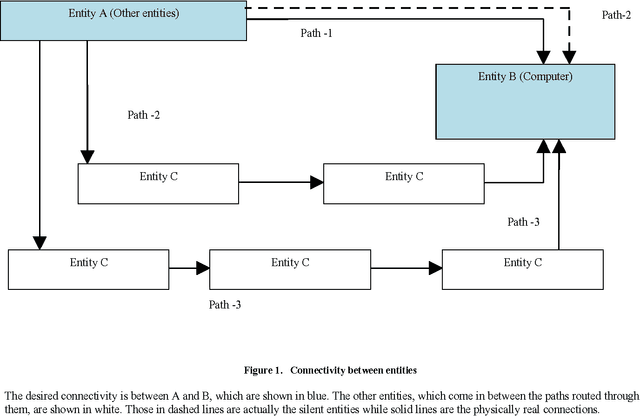Jitesh Dundas
Law of Connectivity in Machine Learning
Jul 01, 2011
Abstract:We present in this paper our law that there is always a connection present between two entities, with a selfconnection being present at least in each node. An entity is an object, physical or imaginary, that is connected by a path (or connection) and which is important for achieving the desired result of the scenario. In machine learning, we state that for any scenario, a subject entity is always, directly or indirectly, connected and affected by single or multiple independent / dependent entities, and their impact on the subject entity is dependent on various factors falling into the categories such as the existenc
* Keywords- Machine Learning; unknown entities; independence; interaction; coverage, silent connections; ISSN 1473-804x online, 1473-8031 print
IBSEAD: - A Self-Evolving Self-Obsessed Learning Algorithm for Machine Learning
Jun 30, 2011Abstract:We present IBSEAD or distributed autonomous entity systems based Interaction - a learning algorithm for the computer to self-evolve in a self-obsessed manner. This learning algorithm will present the computer to look at the internal and external environment in series of independent entities, which will interact with each other, with and/or without knowledge of the computer's brain. When a learning algorithm interacts, it does so by detecting and understanding the entities in the human algorithm. However, the problem with this approach is that the algorithm does not consider the interaction of the third party or unknown entities, which may be interacting with each other. These unknown entities in their interaction with the non-computer entities make an effect in the environment that influences the information and the behaviour of the computer brain. Such details and the ability to process the dynamic and unsettling nature of these interactions are absent in the current learning algorithm such as the decision tree learning algorithm. IBSEAD is able to evaluate and consider such algorithms and thus give us a better accuracy in simulation of the highly evolved nature of the human brain. Processes such as dreams, imagination and novelty, that exist in humans are not fully simulated by the existing learning algorithms. Also, Hidden Markov models (HMM) are useful in finding "hidden" entities, which may be known or unknown. However, this model fails to consider the case of unknown entities which maybe unclear or unknown. IBSEAD is better because it considers three types of entities- known, unknown and invisible. We present our case with a comparison of existing algorithms in known environments and cases and present the results of the experiments using dry run of the simulated runs of the existing machine learning algorithms versus IBSEAD.
* Keywords: Self-evolving algorithm; machine learning; decision-trees; learning algorithms, Hidden Markov Models; http://ijcset.excelingtech.co.uk/vol1issue4/14-vol1issue4.pdf
Implementing Human-like Intuition Mechanism in Artificial Intelligence
Jun 29, 2011
Abstract:Human intuition has been simulated by several research projects using artificial intelligence techniques. Most of these algorithms or models lack the ability to handle complications or diversions. Moreover, they also do not explain the factors influencing intuition and the accuracy of the results from this process. In this paper, we present a simple series based model for implementation of human-like intuition using the principles of connectivity and unknown entities. By using Poker hand datasets and Car evaluation datasets, we compare the performance of some well-known models with our intuition model. The aim of the experiment was to predict the maximum accurate answers using intuition based models. We found that the presence of unknown entities, diversion from the current problem scenario, and identifying weakness without the normal logic based execution, greatly affects the reliability of the answers. Generally, the intuition based models cannot be a substitute for the logic based mechanisms in handling such problems. The intuition can only act as a support for an ongoing logic based model that processes all the steps in a sequential manner. However, when time and computational cost are very strict constraints, this intuition based model becomes extremely important and useful, because it can give a reasonably good performance. Factors affecting intuition are analyzed and interpreted through our model.
 Add to Chrome
Add to Chrome Add to Firefox
Add to Firefox Add to Edge
Add to Edge